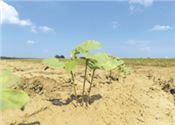|
Strong Cotton Market Drives Acreage Up

STARKVILLE, MISS.
Growers may be on their way to planting more cotton in Mississippi soil than they have in 11 years, despite a late start.
Darrin Dodds, cotton specialist for the Mississippi State University Extension Service, estimated that growers will plant 700,000 acres of cotton this year. If that much gets harvested, it will be the best total since 2006, when the state produced 1.2 million acres of cotton. Last year, Mississippi cotton producers harvested 625,000 acres.
A cool, wet April had growers playing the waiting game, but planting was in full swing by May 2. Hot, mostly dry conditions over the last two weeks have allowed them to catch up.
“The weather was wet and cool for so long that there were people wanting to plant corn but couldn’t do it, so they went with cotton,” Dodds said. “We have covered a tremendous amount of ground in last two weeks because we have been running as hard as we can.”
A number of growers are finished planting, but several others are waiting on either dry weather or rain, depending on where they are. The U.S. Department of Agriculture estimated that 46 percent of the crop had been planted by May 14.
“Parts of northern Mississippi and the northern Delta saw some pop-up showers this week,” Dodds said. “With the exception of those pockets, an inch or so of rain wouldn’t hurt anybody’s feelings.”
The main driver behind the uptick in cotton planting has been a favorable market for growers.
December cotton futures are trading for about 80.5 cents a pound, while south Delta cash cotton is selling for 83 cents a pound. Brian Williams, Extension agricultural economist, said the December futures contract is the tool producers are most likely to use if they want to lock in a price for the fall. South Delta cash cotton is the price they would receive if they were to sell their cotton today.
“Cotton demand has been very strong lately, which has provided a nice boost to prices,” Williams said. “The biggest source of demand has continued to be a healthy export market, with exports currently on pace to top year-ago levels.”
The crop is typically grown in large fields of 1,000 or more acres and picked using modules that can cost up to $1 million. However, producers with smaller fields typically used for other crops are using that land for cotton to take advantage of the strong market.
“It’s hard to get a good gauge on how much, but a good bit of custom harvest will happen,” Dodds said. “If you’re not planting enough to own a picker, you are hiring someone else. On the other side of the coin, you may have a picker and get done with your crop in a timely manner before your neighbor hires you to pick his as well.”
MSU Extension faculty and staff plant variety trials at 35-40 farms across the state each year to evaluate how different types of cotton perform in various conditions and soils. They share the results with cotton growers to help them choose the best varieties for their locations and determine the most effective management strategies.
“Weed control drives a lot of planting decisions,” Dodds said. “Palmer amaranth has been our biggest weed problem. We stress to growers to use a strict weed management program and use residual herbicides like 2,4-D and dicamba when necessary.”
Dodds said most growers have taken for granted a crucial variable in recent years: drainage.
“In a lot of cases over the last several years, we’re cutting water furrows and draining our fields, but the areas our fields drain into are themselves not well drained,” Dodds said. “That leads to a backlog of water in some of the tail ditches and water furrows.”
Extension specialists also use outlets like the new Mississippi Crop Situation Podcast to inform growers on the latest developments in every crop grown in the state. To listen to podcasts from Dodds and other Extension specialists, visit
http://extension.msstate.edu/shows. ∆
|
|